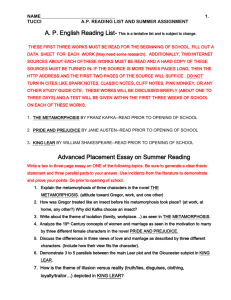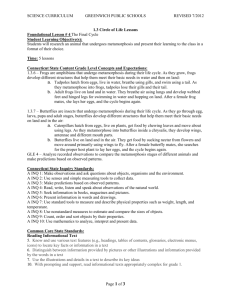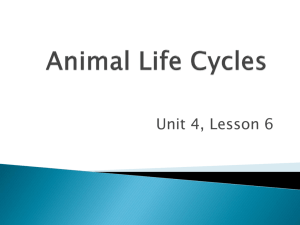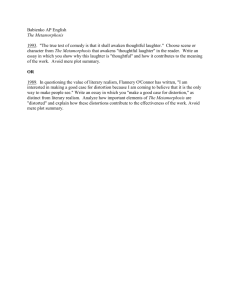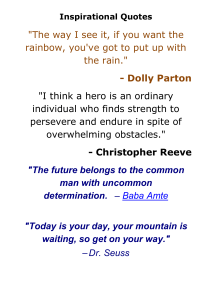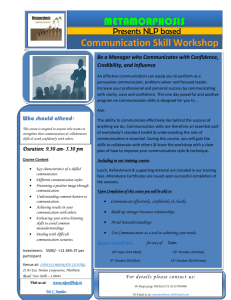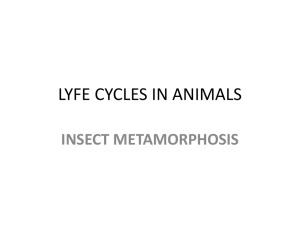Foundational Lesson # 3 - Grade 1 Transdisciplinary Learning
advertisement
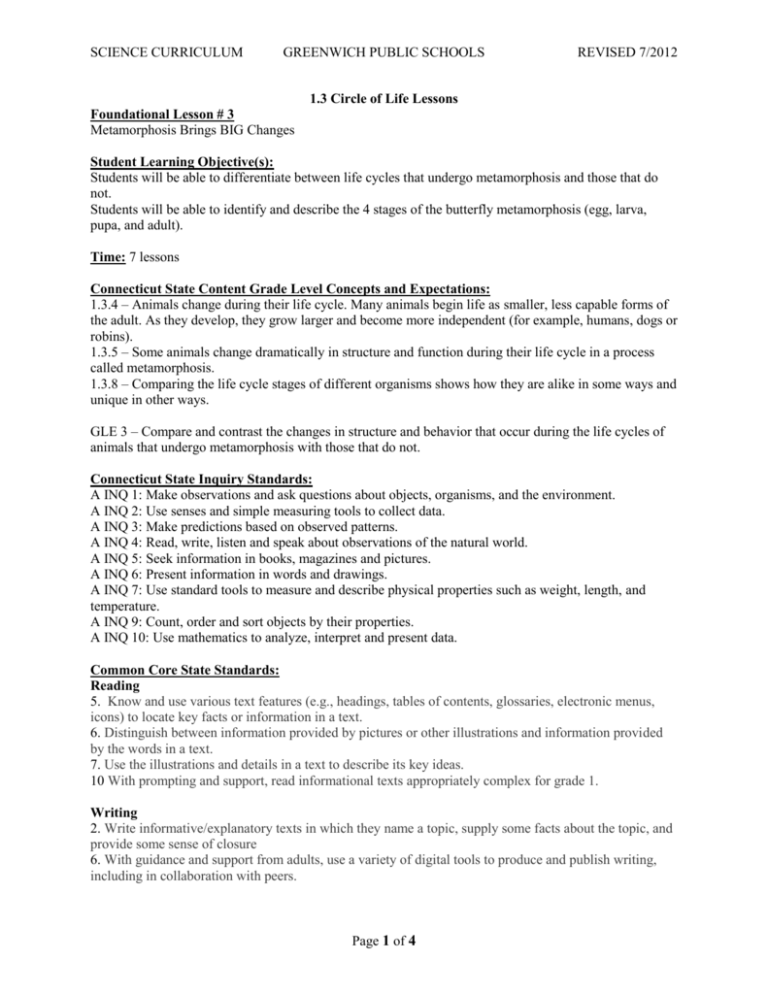
SCIENCE CURRICULUM GREENWICH PUBLIC SCHOOLS REVISED 7/2012 1.3 Circle of Life Lessons Foundational Lesson # 3 Metamorphosis Brings BIG Changes Student Learning Objective(s): Students will be able to differentiate between life cycles that undergo metamorphosis and those that do not. Students will be able to identify and describe the 4 stages of the butterfly metamorphosis (egg, larva, pupa, and adult). Time: 7 lessons Connecticut State Content Grade Level Concepts and Expectations: 1.3.4 – Animals change during their life cycle. Many animals begin life as smaller, less capable forms of the adult. As they develop, they grow larger and become more independent (for example, humans, dogs or robins). 1.3.5 – Some animals change dramatically in structure and function during their life cycle in a process called metamorphosis. 1.3.8 – Comparing the life cycle stages of different organisms shows how they are alike in some ways and unique in other ways. GLE 3 – Compare and contrast the changes in structure and behavior that occur during the life cycles of animals that undergo metamorphosis with those that do not. Connecticut State Inquiry Standards: A INQ 1: Make observations and ask questions about objects, organisms, and the environment. A INQ 2: Use senses and simple measuring tools to collect data. A INQ 3: Make predictions based on observed patterns. A INQ 4: Read, write, listen and speak about observations of the natural world. A INQ 5: Seek information in books, magazines and pictures. A INQ 6: Present information in words and drawings. A INQ 7: Use standard tools to measure and describe physical properties such as weight, length, and temperature. A INQ 9: Count, order and sort objects by their properties. A INQ 10: Use mathematics to analyze, interpret and present data. Common Core State Standards: Reading 5. Know and use various text features (e.g., headings, tables of contents, glossaries, electronic menus, icons) to locate key facts or information in a text. 6. Distinguish between information provided by pictures or other illustrations and information provided by the words in a text. 7. Use the illustrations and details in a text to describe its key ideas. 10 With prompting and support, read informational texts appropriately complex for grade 1. Writing 2. Write informative/explanatory texts in which they name a topic, supply some facts about the topic, and provide some sense of closure 6. With guidance and support from adults, use a variety of digital tools to produce and publish writing, including in collaboration with peers. Page 1 of 4 SCIENCE CURRICULUM GREENWICH PUBLIC SCHOOLS REVISED 7/2012 7. Participate in shared research and writing projects (e.g., explore a number of “how-to” books on a given topic and use them to write a sequence of instructions) Speaking and Listening 5. Add drawings or other visual displays to descriptions when appropriate to clarify ideas, thoughts, and feelings. 6. Produce complete sentences when appropriate to task and situation. Language 1. Demonstrate command of the conventions of standard English grammar and usage when writing or speaking. 2. Demonstrate command of the conventions of standard English capitalization, punctuation, and spelling when writing. Learner Background: Students know how to use magnifying glasses. Students understand the difference between fiction and nonfiction. Teacher Background: Students continue their daily observations of the caterpillars/butterflies and record changes in their Science Notebooks. It is important to be clear about life cycles that experience metamorphosis and those that do not. Metamorphosis is when there is a dramatic change in structure (lungs, wings, etc) and the adult gets its basic needs (Shelter, Water, Air, Nutrients, Sun) met in different ways. For more information: http://www.kidzone.ws/animals/lifecycle.htm Teacher may choose to watch this video and use it with students as an introduction to metamorphosis. http://www.teachersdomain.org/resource/tdc02.sci.life.cyc.metamorph/ Please refer to the Circle of Life Transdis Unit Matrix to know when to begin to work on nonfiction research project for their Expert Books. Suggested Learning Activities: Connect: We have been learning about life cycles and how some animals are born alive and some hatch from eggs. We will read a book about an animal that hatches from an egg, but is very different from a chicken or a snake because it will look and act very different in the beginning and end of its life cycle. Read Aloud: The Very Hungry Caterpillar, Eric Carle. Turn and talk: “What big changes did you notice?” “Why do you think the caterpillar was so hungry? What happens at the end?” Explain how the caterpillar went through a metamorphosis because it looks and acts very different in the beginning and end of its life. Teach the four stages of metamorphosis (egg, larva, pupa, and adult) and what happens in each stage. Get (or draw) a picture of each stage and write their definitions on a chart paper. (Teacher may want to enlarge the attached life cycle pictures and use them.) Students reflect on new learning in science notebooks. (good breaking point) Page 2 of 4 SCIENCE CURRICULUM GREENWICH PUBLIC SCHOOLS REVISED 7/2012 Complete T charts for Caterpillar vs. Butterfly, and for Chick vs. Chicken. They will include facts they noticed about each animal and see how the structure and function of the butterfly changes drastically, while the chicken stays mostly the same. For example: Caterpillar Butterfly has feet has many hairs sticking out from its body has two wings has smooth hairs in the middle Note: (Use these T charts to assess which students understand the difference between animals that undergo metamorphosis and those that do not. Re-teach this concept, if necessary.) (good breaking point) Have students bring their completed T- charts from the last session to the meeting area. Using a teacher made large T- chart, have students share their information and create one large group chart to post in class. (good breaking point) Watch video (about frogs, dragonflies and butterflies) Instruct student to look and listen for new facts using captions for better understanding. http://www.teachersdomain.org/resource/tdc02.sci.life.cyc.metamorph/ Students use Student Notebooks to write facts they learned and what they still wonder. (good breaking point) Writing prompt for Science Notebook What is the difference between how you grow up and how a caterpillar grows up? Share out with partners and/or class. (good breaking point) Teachers will introduce the non-fiction research project (as previously stated, this could be started earlier in the unit) (*See GPS Reading and Writing Units: “Nonfiction Research: Research Based Writing” for detailed lesson plans.*) Individuals will work together to research an animal that undergoes metamorphosis (butterfly, frog, fly, mealworm, ladybug, ant, wasp...) using available books, videos, and reference materials. Resources should include: Capstone texts, website resources (www.pebblego.com), and your school’s media center to perform research from a variety of sources. (If there are not a sufficient amount of resources on animals that undergo metamorphosis, some students may research a different animal.) Page 3 of 4 SCIENCE CURRICULUM GREENWICH PUBLIC SCHOOLS REVISED 7/2012 Each individual student will write a nonfiction book based on this research called an “Expert Book.” Each book will include: each stage of the organism’s life cycle, “SWANS” (shelter or safe space, water, air, nutrients, sun) information for their particular organism, three or more features of nonfiction (student choice), three or more facts about their organism such as: how long they live, predators, color, description, fun facts, etc. These books will take about 3 weeks to research, write, and illustrate and will be used to create a final presentation where students share their new learning with the class (the summative assessment) Differentiation Suggestions: Extension: Students may choose to research an interesting fact they noticed about the butterflies living in the classroom. They can also chart growth or speed at which larva become butterflies. Support: Labels and charts on the wiki Assessment: Science notebooks Expert book Materials / Resources: The Very Hungry Caterpillar, Eric Carle Discovery Education (United Streaming) video: Metamorphosis: Change of Plans. (Teacher needs to create a free login name. http://www.teachersdomain.org/resource/tdc02.sci.life.cyc.metamorph/ Capstone books: The Life Cycle of... (chicken, kangaroo, cow, grasshopper, frog, sunflower...) Page 4 of 4
